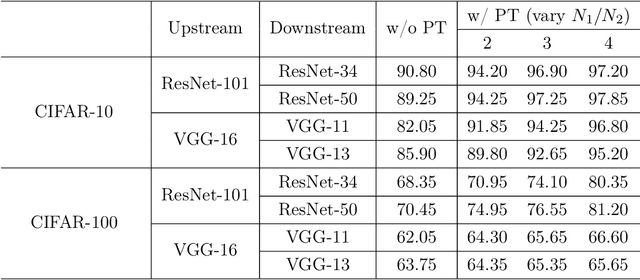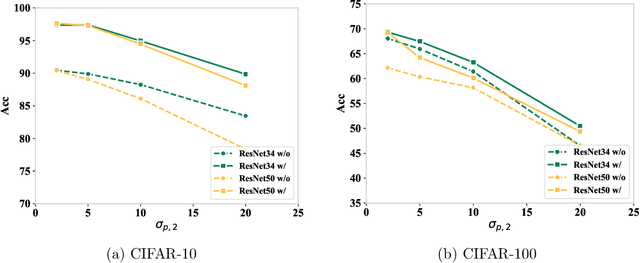Xin Geng
Fast Inference of Visual Autoregressive Model with Adjacency-Adaptive Dynamical Draft Trees
Dec 26, 2025Abstract:Autoregressive (AR) image models achieve diffusion-level quality but suffer from sequential inference, requiring approximately 2,000 steps for a 576x576 image. Speculative decoding with draft trees accelerates LLMs yet underperforms on visual AR models due to spatially varying token prediction difficulty. We identify a key obstacle in applying speculative decoding to visual AR models: inconsistent acceptance rates across draft trees due to varying prediction difficulties in different image regions. We propose Adjacency-Adaptive Dynamical Draft Trees (ADT-Tree), an adjacency-adaptive dynamic draft tree that dynamically adjusts draft tree depth and width by leveraging adjacent token states and prior acceptance rates. ADT-Tree initializes via horizontal adjacency, then refines depth/width via bisectional adaptation, yielding deeper trees in simple regions and wider trees in complex ones. The empirical evaluations on MS-COCO 2017 and PartiPrompts demonstrate that ADT-Tree achieves speedups of 3.13xand 3.05x, respectively. Moreover, it integrates seamlessly with relaxed sampling methods such as LANTERN, enabling further acceleration. Code is available at https://github.com/Haodong-Lei-Ray/ADT-Tree.
Knowledge Diversion for Efficient Morphology Control and Policy Transfer
Dec 10, 2025Abstract:Universal morphology control aims to learn a universal policy that generalizes across heterogeneous agent morphologies, with Transformer-based controllers emerging as a popular choice. However, such architectures incur substantial computational costs, resulting in high deployment overhead, and existing methods exhibit limited cross-task generalization, necessitating training from scratch for each new task. To this end, we propose \textbf{DivMorph}, a modular training paradigm that leverages knowledge diversion to learn decomposable controllers. DivMorph factorizes randomly initialized Transformer weights into factor units via SVD prior to training and employs dynamic soft gating to modulate these units based on task and morphology embeddings, separating them into shared \textit{learngenes} and morphology- and task-specific \textit{tailors}, thereby achieving knowledge disentanglement. By selectively activating relevant components, DivMorph enables scalable and efficient policy deployment while supporting effective policy transfer to novel tasks. Extensive experiments demonstrate that DivMorph achieves state-of-the-art performance, achieving a 3$\times$ improvement in sample efficiency over direct finetuning for cross-task transfer and a 17$\times$ reduction in model size for single-agent deployment.
Stratified Knowledge-Density Super-Network for Scalable Vision Transformers
Nov 12, 2025Abstract:Training and deploying multiple vision transformer (ViT) models for different resource constraints is costly and inefficient. To address this, we propose transforming a pre-trained ViT into a stratified knowledge-density super-network, where knowledge is hierarchically organized across weights. This enables flexible extraction of sub-networks that retain maximal knowledge for varying model sizes. We introduce \textbf{W}eighted \textbf{P}CA for \textbf{A}ttention \textbf{C}ontraction (WPAC), which concentrates knowledge into a compact set of critical weights. WPAC applies token-wise weighted principal component analysis to intermediate features and injects the resulting transformation and inverse matrices into adjacent layers, preserving the original network function while enhancing knowledge compactness. To further promote stratified knowledge organization, we propose \textbf{P}rogressive \textbf{I}mportance-\textbf{A}ware \textbf{D}ropout (PIAD). PIAD progressively evaluates the importance of weight groups, updates an importance-aware dropout list, and trains the super-network under this dropout regime to promote knowledge stratification. Experiments demonstrate that WPAC outperforms existing pruning criteria in knowledge concentration, and the combination with PIAD offers a strong alternative to state-of-the-art model compression and model expansion methods.
* Accepted by AAAI 2026
One-Shot Knowledge Transfer for Scalable Person Re-Identification
Nov 08, 2025Abstract:Edge computing in person re-identification (ReID) is crucial for reducing the load on central cloud servers and ensuring user privacy. Conventional compression methods for obtaining compact models require computations for each individual student model. When multiple models of varying sizes are needed to accommodate different resource conditions, this leads to repetitive and cumbersome computations. To address this challenge, we propose a novel knowledge inheritance approach named OSKT (One-Shot Knowledge Transfer), which consolidates the knowledge of the teacher model into an intermediate carrier called a weight chain. When a downstream scenario demands a model that meets specific resource constraints, this weight chain can be expanded to the target model size without additional computation. OSKT significantly outperforms state-of-the-art compression methods, with the added advantage of one-time knowledge transfer that eliminates the need for frequent computations for each target model.
* Accepted by ICCV 2025
Enriching Knowledge Distillation with Intra-Class Contrastive Learning
Sep 26, 2025Abstract:Since the advent of knowledge distillation, much research has focused on how the soft labels generated by the teacher model can be utilized effectively. Existing studies points out that the implicit knowledge within soft labels originates from the multi-view structure present in the data. Feature variations within samples of the same class allow the student model to generalize better by learning diverse representations. However, in existing distillation methods, teacher models predominantly adhere to ground-truth labels as targets, without considering the diverse representations within the same class. Therefore, we propose incorporating an intra-class contrastive loss during teacher training to enrich the intra-class information contained in soft labels. In practice, we find that intra-class loss causes instability in training and slows convergence. To mitigate these issues, margin loss is integrated into intra-class contrastive learning to improve the training stability and convergence speed. Simultaneously, we theoretically analyze the impact of this loss on the intra-class distances and inter-class distances. It has been proved that the intra-class contrastive loss can enrich the intra-class diversity. Experimental results demonstrate the effectiveness of the proposed method.
Towards Understanding Feature Learning in Parameter Transfer
Sep 26, 2025



Abstract:Parameter transfer is a central paradigm in transfer learning, enabling knowledge reuse across tasks and domains by sharing model parameters between upstream and downstream models. However, when only a subset of parameters from the upstream model is transferred to the downstream model, there remains a lack of theoretical understanding of the conditions under which such partial parameter reuse is beneficial and of the factors that govern its effectiveness. To address this gap, we analyze a setting in which both the upstream and downstream models are ReLU convolutional neural networks (CNNs). Within this theoretical framework, we characterize how the inherited parameters act as carriers of universal knowledge and identify key factors that amplify their beneficial impact on the target task. Furthermore, our analysis provides insight into why, in certain cases, transferring parameters can lead to lower test accuracy on the target task than training a new model from scratch. Numerical experiments and real-world data experiments are conducted to empirically validate our theoretical findings.
Foundation Model for Skeleton-Based Human Action Understanding
Aug 18, 2025Abstract:Human action understanding serves as a foundational pillar in the field of intelligent motion perception. Skeletons serve as a modality- and device-agnostic representation for human modeling, and skeleton-based action understanding has potential applications in humanoid robot control and interaction. \RED{However, existing works often lack the scalability and generalization required to handle diverse action understanding tasks. There is no skeleton foundation model that can be adapted to a wide range of action understanding tasks}. This paper presents a Unified Skeleton-based Dense Representation Learning (USDRL) framework, which serves as a foundational model for skeleton-based human action understanding. USDRL consists of a Transformer-based Dense Spatio-Temporal Encoder (DSTE), Multi-Grained Feature Decorrelation (MG-FD), and Multi-Perspective Consistency Training (MPCT). The DSTE module adopts two parallel streams to learn temporal dynamic and spatial structure features. The MG-FD module collaboratively performs feature decorrelation across temporal, spatial, and instance domains to reduce dimensional redundancy and enhance information extraction. The MPCT module employs both multi-view and multi-modal self-supervised consistency training. The former enhances the learning of high-level semantics and mitigates the impact of low-level discrepancies, while the latter effectively facilitates the learning of informative multimodal features. We perform extensive experiments on 25 benchmarks across across 9 skeleton-based action understanding tasks, covering coarse prediction, dense prediction, and transferred prediction. Our approach significantly outperforms the current state-of-the-art methods. We hope that this work would broaden the scope of research in skeleton-based action understanding and encourage more attention to dense prediction tasks.
DivControl: Knowledge Diversion for Controllable Image Generation
Jul 31, 2025Abstract:Diffusion models have advanced from text-to-image (T2I) to image-to-image (I2I) generation by incorporating structured inputs such as depth maps, enabling fine-grained spatial control. However, existing methods either train separate models for each condition or rely on unified architectures with entangled representations, resulting in poor generalization and high adaptation costs for novel conditions. To this end, we propose DivControl, a decomposable pretraining framework for unified controllable generation and efficient adaptation. DivControl factorizes ControlNet via SVD into basic components-pairs of singular vectors-which are disentangled into condition-agnostic learngenes and condition-specific tailors through knowledge diversion during multi-condition training. Knowledge diversion is implemented via a dynamic gate that performs soft routing over tailors based on the semantics of condition instructions, enabling zero-shot generalization and parameter-efficient adaptation to novel conditions. To further improve condition fidelity and training efficiency, we introduce a representation alignment loss that aligns condition embeddings with early diffusion features. Extensive experiments demonstrate that DivControl achieves state-of-the-art controllability with 36.4$\times$ less training cost, while simultaneously improving average performance on basic conditions. It also delivers strong zero-shot and few-shot performance on unseen conditions, demonstrating superior scalability, modularity, and transferability.
PAMD: Plausibility-Aware Motion Diffusion Model for Long Dance Generation
May 26, 2025Abstract:Computational dance generation is crucial in many areas, such as art, human-computer interaction, virtual reality, and digital entertainment, particularly for generating coherent and expressive long dance sequences. Diffusion-based music-to-dance generation has made significant progress, yet existing methods still struggle to produce physically plausible motions. To address this, we propose Plausibility-Aware Motion Diffusion (PAMD), a framework for generating dances that are both musically aligned and physically realistic. The core of PAMD lies in the Plausible Motion Constraint (PMC), which leverages Neural Distance Fields (NDFs) to model the actual pose manifold and guide generated motions toward a physically valid pose manifold. To provide more effective guidance during generation, we incorporate Prior Motion Guidance (PMG), which uses standing poses as auxiliary conditions alongside music features. To further enhance realism for complex movements, we introduce the Motion Refinement with Foot-ground Contact (MRFC) module, which addresses foot-skating artifacts by bridging the gap between the optimization objective in linear joint position space and the data representation in nonlinear rotation space. Extensive experiments show that PAMD significantly improves musical alignment and enhances the physical plausibility of generated motions. This project page is available at: https://mucunzhuzhu.github.io/PAMD-page/.
FAD: Frequency Adaptation and Diversion for Cross-domain Few-shot Learning
May 13, 2025Abstract:Cross-domain few-shot learning (CD-FSL) requires models to generalize from limited labeled samples under significant distribution shifts. While recent methods enhance adaptability through lightweight task-specific modules, they operate solely in the spatial domain and overlook frequency-specific variations that are often critical for robust transfer. We observe that spatially similar images across domains can differ substantially in their spectral representations, with low and high frequencies capturing complementary semantic information at coarse and fine levels. This indicates that uniform spatial adaptation may overlook these spectral distinctions, thus constraining generalization. To address this, we introduce Frequency Adaptation and Diversion (FAD), a frequency-aware framework that explicitly models and modulates spectral components. At its core is the Frequency Diversion Adapter, which transforms intermediate features into the frequency domain using the discrete Fourier transform (DFT), partitions them into low, mid, and high-frequency bands via radial masks, and reconstructs each band using inverse DFT (IDFT). Each frequency band is then adapted using a dedicated convolutional branch with a kernel size tailored to its spectral scale, enabling targeted and disentangled adaptation across frequencies. Extensive experiments on the Meta-Dataset benchmark demonstrate that FAD consistently outperforms state-of-the-art methods on both seen and unseen domains, validating the utility of frequency-domain representations and band-wise adaptation for improving generalization in CD-FSL.
 Add to Chrome
Add to Chrome Add to Firefox
Add to Firefox Add to Edge
Add to Edge